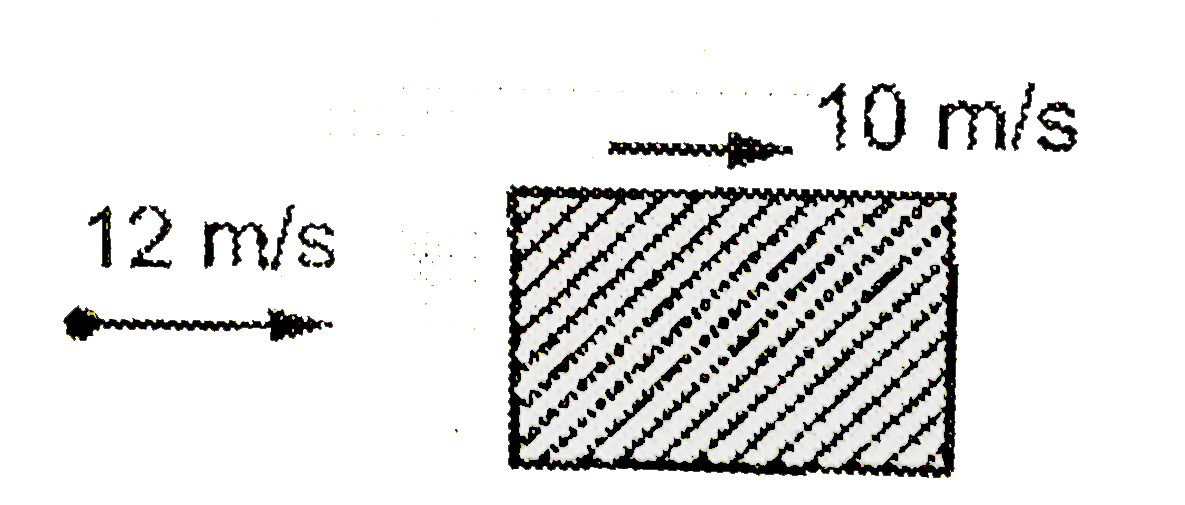A block movig horizontally ona smooth surace with a speed of 20 m/s bursts into thwo equal parts cobtinuing in the same direction. If one of the parts moves at 30 m/s, with whast speed does the second part move and what is tehfractional change in the kinetic energy?
There is no exterN/Al force on the block. InterN/Al forces break the block in two parts. The liear momentum of the block befoe the break shuld therefore be equal to tehlinear momentum of the wo parts after the break. As all thevelocities are in same directin we get
M(20ms)=M2(30ms)+M2v
where v is th speed of the other part. From this equation v=10ms. The change in kinetic energy is 12M2(3ms)2+12M2(10ms)2−12M(20ms)2
=m450+50−40m2s2=(50m2s2)M.
HencethetioNAlchan≥∈thek∈etice≠rgy<br>(M(50 m^2/s^2))/(1/2M(20m/s)^2)=1/4
Similar Questions
A block moving horizontally on a smooth surface with a speed of 40 m/s splits into two parts with messes in the ratio of 1:2 If the smaller part moves at 60 m/s in the same direction , then fractional change in kinetic energy is :
View SolutionA block moving horizontally on a smooth surface with a speed of 40 ms−1 splits into two equal parts. If one of the parts moves at 60 ms1 in the same direction, then the fractional change in the kinetic energy will be x : 4 where x =__________
View Solution
Knowledge Check
A moving train 66 metres long overtakes another train of 88 metres long, moving in the same direction in 0.168 minutes. If the second train is moving at 30 km/hr, at what speed is the first train moving?
A85 km/hrB50 km/hrC55 km/hrD25 km/hrA light particle moving horizontally with a speed of 12 m/s strikes a very heavy block moving in the same direction at 10 m/s. The collision is one dimensional and elastic. After the collision, the particle will be
 Amove at 2 m/s in its original directionBmove at 8 m/s in its original directionCmove at 8 m/s opposite to its original directionDmove at 12 m/s opposite to its original direction
Amove at 2 m/s in its original directionBmove at 8 m/s in its original directionCmove at 8 m/s opposite to its original directionDmove at 12 m/s opposite to its original directionA light particle moving horizontally with a speed of 12m/s strikes a very heavy block moving in the same direction at 10m/s. The collision is one-dimensional and elastic. After the collision, the particle will
 Amove at 2m/s in its original directionBmove at 8m/s in its original directionCmove at 8m/s opposite to its original directionDmove at 12m/s opposite to its original direction
Amove at 2m/s in its original directionBmove at 8m/s in its original directionCmove at 8m/s opposite to its original directionDmove at 12m/s opposite to its original direction
A particle is moving along x-axis with velocity 40 m/s. It breaks into two parts in mass ratio 1:2. If speed of smaller part is 60 m/s along x-axis then find fractional changes in kinetic energy of system.
View SolutionA light particle moving horizontally with a speed of 12m/s strikes a very heavy block moving in the same direction at 10m/s. The collision is one-dimensional and elastic. After the collision, the particle will

View SolutionA projectile is moving at 60m/s at its highest point, where it breaks into two equal parts due to an internal explosion. One part moves vertically up at 50m/s with respect to the ground. The other part will move at
View SolutionA body of mass 4m is split into two equal parts by an internal explosion which generates a kinetic energy E. If, after the explosion, the parts move in the same line as before, then what is their relative speed?
View SolutionA cartis moving horizontally along a straight line with constant speed 30m/s.At projectile is to be fired from the moving cart in such a way that it will return to the cart after the cart has moved 8Om. At what speed (relative to the cart) must the projectile be fired? (Take g=10m/s2)
View Solution
